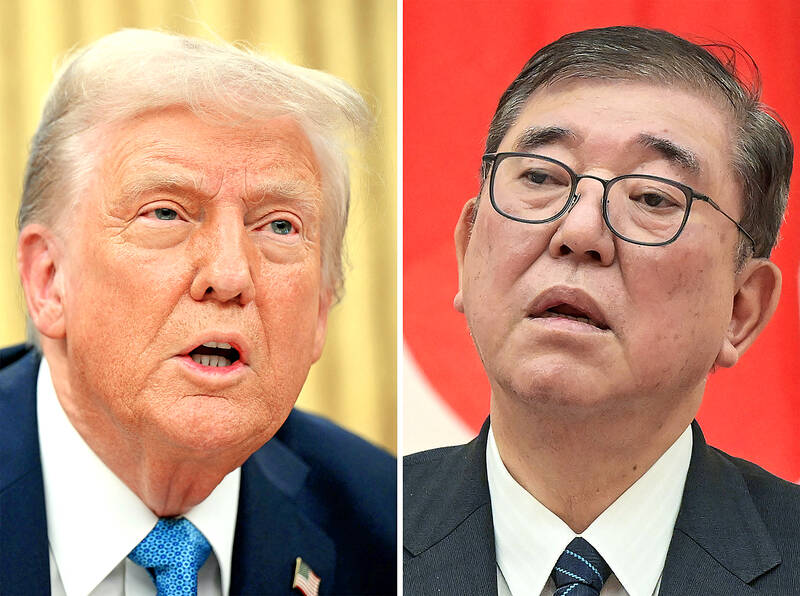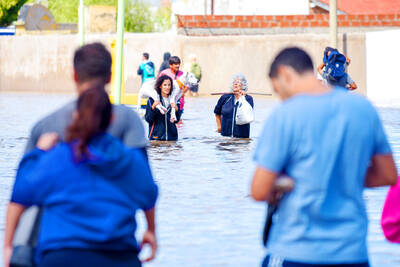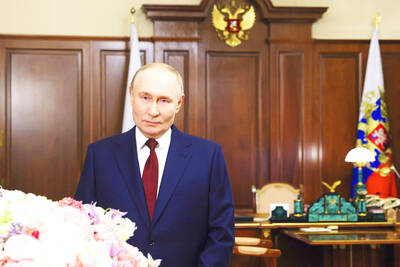Japanese Prime Minister Shigeru Ishiba yesterday headed to the US ahead of what would be US President Donald Trump’s second summit with a foreign leader since his return to the White House.
Japan is one of the closest allies of the US in Asia with about 54,000 US military personnel stationed in the country.
Ishiba would be pushing for reassurance on the importance of the US-Japan alliance, as Trump’s “America First” agenda risks encroaching on the nation’s trade and defense ties.

Photo: AFP
He might also propose increasing imports of US natural gas, local media said, chiming with Trump’s plan to “drill, baby, drill” while boosting energy security for resource-poor Japan.
“The intention is to present a win-win value proposition from Ishiba to the president,” said Sheila Smith, senior fellow at the Council on Foreign Relations.
Also, “Japan has cut its liquefied natural gas [LNG] imports from Russia. So Japan desperately needs to open up new sources of LNG, and other energy more broadly,” she said.
Trump would meet Ishiba in Washington today, just days after a joint news conference with Israeli Prime Minister Benjamin Netanyahu, where the US president sparked uproar with a proposal to take over the Gaza Strip.
The Japan summit could be less startling, as Trump “has a fairly strong commitment to the alliances in Asia,” Smith said.
“This is probably a very calm, cool reassurance meeting,” she said.
On defense, both sides plan to state Washington’s “unwavering commitment” to Japan’s defense, the Yomiuri Shimbun reported.
However, as Japan and the US renegotiate how to share the burden of defense costs, there are concerns Trump could provide less cash and push Japan to do more, Smith said.
“That’s where ... the Ishiba-Trump relationship could get a bit sticky,” she said.
Trump’s willingness to slap trade tariffs on major trading partners Canada, Mexico and China has also caused jitters.
“I hope Ishiba will show him there are other ways to achieve economic security,” such as cooperating on technology, said Takashi Shiraishi, a professor and international relations expert at the Prefectural University of Kumamoto.
One example is the Stargate drive, announced after Trump’s inauguration, to invest up to US$500 billion in artificial intelligence infrastructure in the US, led by Japanese tech investment behemoth Softbank Corp and US firm OpenAI.
Reports said the leaders could also discuss Nippon Steel’s US$14.9 billion bid to buy US Steel, which former US President Joe Biden blocked on national security grounds.
Japan and the US are each other’s top foreign investors, a point Ishiba could stress during the talks.
During his first term, Trump and then-Japanese prime minister Shinzo Abe enjoyed warm relations.
As US president-elect in December last year, Trump also hosted Akie Abe, the widow of Shinzo Abe for a dinner with Melania Trump at their Florida residence.
Trump built a strong relationship with Shinzo Abe, for whom Smith believes he had a “genuine fondness.”
He would likely “see Ishiba through a different lens,” Smith said. “It will be more the state-to-state relationship, not the personal.”
Ishiba, 68, would not be the first Japanese VIP to meet the 78-year-old Trump in person since he took office — an accolade held by SoftBank founder Masayoshi Son.

ANGER: A video shared online showed residents in a neighborhood confronting the national security minister, attempting to drag her toward floodwaters Argentina’s port city of Bahia Blanca has been “destroyed” after being pummeled by a year’s worth of rain in a matter of hours, killing 13 and driving hundreds from their homes, authorities said on Saturday. Two young girls — reportedly aged four and one — were missing after possibly being swept away by floodwaters in the wake of Friday’s storm. The deluge left hospital rooms underwater, turned neighborhoods into islands and cut electricity to swaths of the city. Argentine Minister of National Security Patricia Bullrich said Bahia Blanca was “destroyed.” The death toll rose to 13 on Saturday, up from 10 on Friday, authorities

Local officials from Russia’s ruling party have caused controversy by presenting mothers of soldiers killed in Ukraine with gifts of meat grinders, an appliance widely used to describe Russia’s brutal tactics on the front line. The United Russia party in the northern Murmansk region posted photographs on social media showing officials smiling as they visited bereaved mothers with gifts of flowers and boxed meat grinders for International Women’s Day on Saturday, which is widely celebrated in Russia. The post included a message thanking the “dear moms” for their “strength of spirit and the love you put into bringing up your sons.” It

DEBT BREAK: Friedrich Merz has vowed to do ‘whatever it takes’ to free up more money for defense and infrastructure at a time of growing geopolitical uncertainty Germany’s likely next leader Friedrich Merz was set yesterday to defend his unprecedented plans to massively ramp up defense and infrastructure spending in the Bundestag as lawmakers begin debating the proposals. Merz unveiled the plans last week, vowing his center-right Christian Democratic Union (CDU)/Christian Social Union (CSU) bloc and the center-left Social Democratic Party (SPD) — in talks to form a coalition after last month’s elections — would quickly push them through before the end of the current legislature. Fraying Europe-US ties under US President Donald Trump have fueled calls for Germany, long dependent on the US security umbrella, to quickly

In front of a secluded temple in southwestern China, Duan Ruru skillfully executes a series of chops and strikes, practicing kung fu techniques she has spent a decade mastering. Chinese martial arts have long been considered a male-dominated sphere, but a cohort of Generation Z women like Duan is challenging that assumption and generating publicity for their particular school of kung fu. “Since I was little, I’ve had a love for martial arts... I thought that girls learning martial arts was super swaggy,” Duan, 23, said. The ancient Emei school where she trains in the mountains of China’s Sichuan Province